Oracle® Enterprise Manager Ops Center
Provisioning Oracle Solaris 11 Operating Systems
12c Release 2 (12.2.2.0.0)
E47845-03
December 2014
This document provides an end-to-end example for how to use Oracle Enterprise Manager Ops Center to create and apply a Provision OS deployment plan to install an Oracle Solaris 11.1 operating system on a piece of configured hardware.
1 Introduction
Oracle Enterprise Manager Ops Center streamlines the process of installing an Oracle Solaris 11 operating system (OS) on configured or unconfigured hardware. As shown in Figure 1, when you use Oracle Enterprise Manager Ops Center to provision, you create two profiles to define the provisioning parameters and a plan to apply your configuration selection to target systems.
As shown in Figure 1, the following is an overview of the OS provisioning process:
-
Create an OS Provisioning profile: Defines the OS provisioning parameters, including the platform-specific operating system image and software package, file system layout, user accounts, naming services, and other installation requirements.
-
Create an OS Configuration profile: Defines the OS configuration parameters, including the platform, how the operating system is managed (with or without an agent), MPxIO and networking options.
-
Create an OS Provisioning Deployment Plan: Defines the OS Provisioning and OS Configuration profiles to use for the provisioning job. To successfully create the plan, the OS Provisioning and OS Configuration profiles must be the same sub-type. For example, Solaris SPARC.
-
Apply the OS Provisioning Deployment Plan to selected targets: Selects the targets to provision, defines the boot interface resource assignments, network resource assignments, and server pool assignment (if applicable), and schedule when to begin the provisioning job.
You can reuse the OS Provisioning and OS Configuration profiles and the deployment plan to provision other systems or groups of systems.
Note:
To provision operating systems on logical domains, you must use the OS Provisioning and OS Configuration profiles that have Logical Domains as a subtype. The profiles described in this document provision an operating system on configured systems.See Planning for Operating System Provisioning in the Oracle Enterprise Manager Ops Center Feature Reference Guide for things to consider before provisioning.
Oracle Enterprise Manager Ops Center leverages the Oracle Solaris 11 Automated Installer (AI) feature and simplifies it. For example, you do not need to bootstrap a system, create an Automated Installer server, or configure WAN Boot to provision a system with an Oracle Solaris 11 operating system. Each Proxy Controller that is installed on an Oracle Solaris 11 operating system is designed to act as an Automated Installer server without any configuration on your part. The software configures WAN Boot on either a SPARC or x86 Proxy Controller, then selects it as the default connection.
The platform determines the connection options for provisioning Oracle Solaris 11:
-
SPARC: Uses WAN Boot or DHCP connection. Oracle Enterprise Manager Ops Center automatically configures and uses WAN Boot. You can configure the software to use a DHCP connection on SPARC platforms. When you configure the software to use DHCP, that connection is used for all profiles and plans executed for Oracle Solaris 11 operating systems on SPARC.
-
x86: Uses an ISC DHCP connection.
Oracle Solaris 11 uses group packages to install, or provision, the operating system. The following options are available:
-
Oracle Solaris Large Server: Installs the solaris-large-server packages, which provide an Oracle Solaris large server environment.
-
Oracle Solaris Small Server: Installs the solaris-small-server packages, which provide a useful command-line Oracle Solaris environment.
-
Oracle Solaris Desktop: Installs the solaris-desktop packages, which provide an Oracle Solaris desktop environment.
You create an Oracle Solaris 11 Software Update Library when you install and configure the Oracle Enterprise Manager Ops Center software. The library contains the packages you need to have for provisioning and patching. You can configure the library to sync with the latest information on oracle.com on a set schedule, or you can use the Add Content option to update the library whenever you need to get the latest information. Adding Oracle Solaris 11 images to the software update library creates a default set of OS provisioning and configuration profiles and a default OS Provisioning plan for each image. Default profiles are prefixed with default-. For example, the following is the name of a default OS Provisioning profile: default-profile-Oracle Solaris 11.0 sparc-13.4.0-OracleSolarisSmallServer.
Profiles and plans simplify and standardize the procedures between different operating systems and platforms. The profiles take care of many of the configuration requirements for you and the plan defines the systems to provision and final configuration options, such as the boot interface and network assignments.
Beginning with Oracle Enterprise Manager Ops Center Release 2 (12.2.0.0.0), you will use two profiles to define your OS provisioning job:
-
OS Provisioning profile: Defines the platform, image, provisioning, and installation requirements, such as language, time zone, and console details. For Oracle Solaris 11, you can add an OS Update profile to the OS Provisioning profile. This is useful when you want to install packages as part of provisioning. For example, you can create an OS Update profile to add an FTP package or plug-ins.
-
OS Configuration profile: Defines the platform, operating system, and network configuration.
You can use the default profiles to provision the operating system, or you can keep the default profiles as templates and copy a profile and give it a name that is more meaningful to your organization. You can reuse any of the profiles and plans to quickly install the operating system on an unconfigured bare metal system or on a configured system.
This example shows how to create an OS Update profile to add a desktop Firefox extensions package, copy a default OS Provisioning profile and a default OS Configuration profile to create new profiles, and then create a new Provision OS deployment plan. The profiles and plan will install an Oracle Solaris 11.1 SRU 16.4 desktop operating system on a configured SPARC server using WAN Boot.
See Related Articles and Resources for links to related information and articles.
2 What You Will Need
You need the following to provision an Oracle Solaris 11.1 operating system:
-
Enterprise Controller and Proxy Controller installed on a system running the Oracle Solaris 11.1 or later operating system.
-
Oracle Solaris 11 Software Update Library. This example uses Oracle Solaris 11.1 SRU 16.4 content.
-
Configured hardware to provision.
-
SPARC-based platform with at least OpenBoot PROM (OBP) version 4.17 installed.
-
Updated firmware.
-
Configured service processor.
-
SSH and IPMI Discovery Credentials for the service processor. You can use the system's default credentials or you can create discovery credentials. You will specify the credentials in the discovery profile. See Discovering and Managing Hardware for how to create SSH and IPMI credentials.
-
IP address for the service processor.
-
-
Service processor discovered and visible in the Oracle Enterprise Manager Ops Center UI.
-
A password for root and for the user account that you want to use for your new operating systems.
Note:
Oracle Solaris 11 requires that you add a non-root user, such as admin, during installation. When you create the profile, you define the root password and non-root user name and password. The user name and passwords are configured on the operating system during provisioning. -
Network port and MAC address combination. These are used to connect to the server once it is available on the network.
-
The roles and permissions to complete the tasks. You need the following Oracle Enterprise Manager Ops Center roles:
-
Asset Admin role to discover the service processor.
-
Plan/Profile Admin to create an OS Update profile, OS Provisioning profile, OS Configuration profile, and Provision OS deployment plan.
-
Apply Deployment Plans to apply the plan.
-
3 Provisioning an Oracle Solaris 11 Operating System
Complete the following actions to provision Oracle Solaris 11 operating system on configured and managed hardware:
-
Create an OS Provisioning Profile for Oracle Solaris 11 Operating System
-
Create an OS Configuration Profile for an Oracle Solaris 11 Operating System
You can discover the target asset before or after creating the profiles and plans. After you create the profiles and plan, you can reuse and apply the plan to other target assets.
3.1 Create an OS Update Profile
You have the option to add an Oracle Solaris 11 OS Update profile to install or uninstall packages as part of an OS Provisioning profile. This example shows how to create an OS Update profile that installs a Firefox extension package. You can add the profile to an OS Provisioning profile. An OS Update profile is not required to provision an OS.
-
Expand Plan Management in the Navigation pane, then select Update Profiles under Profiles and Policies.
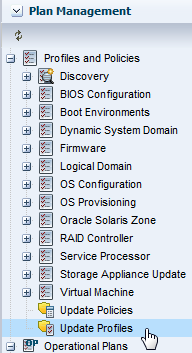
Description of the illustration pm_update_profiles.png
-
Click New Profile in the actions pane. Alternatively, you can right click Update Profiles in step 1, then click New Profile in the Navigation pane.
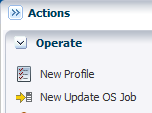
Description of the illustration pm_createprofile.png
-
Enter a name and description for the profile, then select Solaris 11.

Description of the illustration osupdate_name.png
-
Select Distribution, Category, View, and Version from the Search Criteria. Select Show Only Support Repository Updates to further filter the list. The available search criteria are determined by your selection. In this example, select Applications/Plug-ins and Run-times from the Category menu and Latest Versions. A list of available packages appears on the right side of the page.
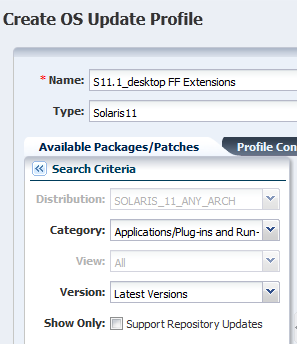
Description of the illustration osupdate_criteria.png
-
To get more information about a package, select the package and click the View Details icon, which is the first icon. To add the Firefox Extensions plug-in package components to the Profile Contents, select the components and click the Install icon.
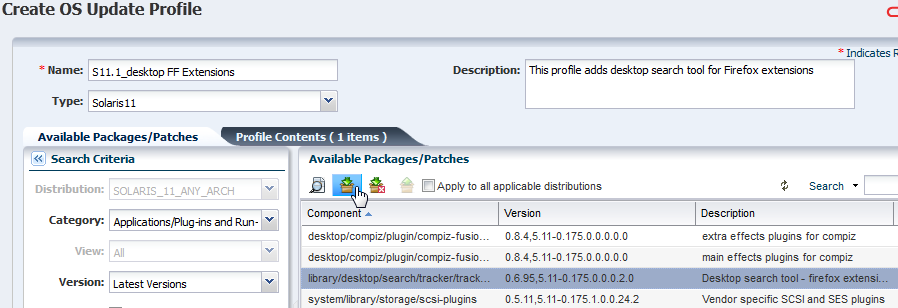
Description of the illustration osp_s11_u_profile.png
-
Click Create OS Update Profile. The profile appears in the list of Update profiles.
3.2 Create an OS Provisioning Profile for Oracle Solaris 11 Operating System
You can use the default profiles, make a copy of a default profile, or create a profile. One of the advantages to copying a default profile is that the correct platform, operating system image, and software group are pre-selected based on the image. This example shows how to copy the default-profile-Oracle Solaris 11.1 SPARC-16.4.0-OracleSolarisDesktop default profile to create a profile.
-
Expand Plan Management in the Navigation pane, then select OS Provisioning in the Profiles and Policies navigation tree.
A list of OS profiles appears in the center pane. Resize the column to view the entire profile name.
-
Select the default profile for the image. In this case, default-profile-Oracle Solaris 11.1 SPARC-16.4-OracleSolarisDesktop. Click the Copy Profile icon in the center pane.

Description of the illustration osp_default_s11.png
-
Rename the profile. Revise and expand the profile description. The subtype and target type are based on the image and are not editable. Click Next.

Description of the illustration osp_profile_id.png
-
On the Specify OSP Parameters page, the OS image, OS Image Version, and Software group are already selected based on the image. You can select one or more feature software groups. This example does not use additional feature software groups, but it does include the S11.1_desktop FF Extensions Oracle Solaris 11 OS Update profile created earlier. Select the profile from the list of user-defined update profiles. Click Next.
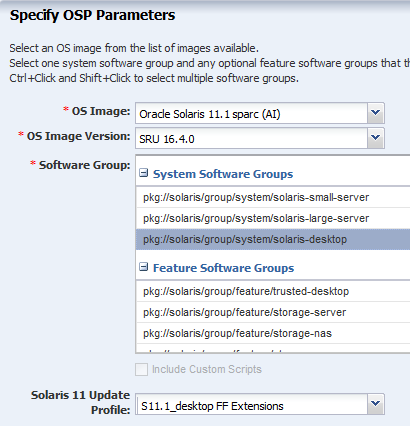
Description of the illustration osp_parameters.png
-
Specify the OS Setup parameters by editing the default values, as needed and entering the root password twice. Click Next.
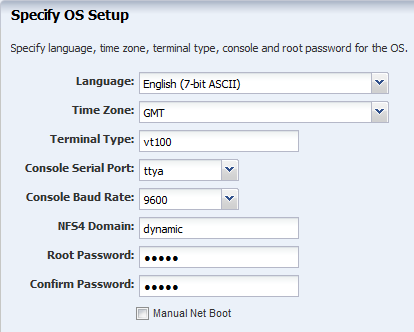
Description of the illustration osp_setup.png
-
Language: Select a language from the list.
-
Time Zone: Specify the time zone for the operating system.
-
Terminal Type: Select a terminal type from the list.
-
Console Serial Port: To monitor the installation using a serial connection, select the correct console serial port device.
-
Console Baud Rate: To monitor the installation using a serial connection, select the correct serial port device baud rate.
-
NFS4 Domain: Enter the NFS4 domain name that the target system will use. The dynamic value for NFSv4 domain name enables the NFSv4 domain to be derived dynamically, at run time, based on the naming service configuration. You can also provide valid domain name to hard code the value for NFSv4 domain.
-
Password: Enter the root password for the root user on systems provisioned using this profile. Re-enter the password for confirmation. The default password is admin.
-
-
Specify the User Account details, such as an admin user, then click Next. You cannot use root as the login user name.
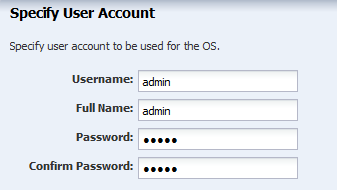
Description of the illustration osp_profile_useracct.png
-
Click Next. This example does not use an iSCSI Disk for operating system provisioning.

Description of the illustration osp_iscsi_usage.png
-
Review and edit the default file system layout, then click Next.
This example uses the default file system parameters. To change the default File System space allocation, click the size field and enter a new size.
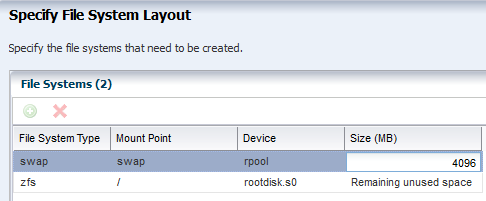
Description of the illustration osp_profile_fileys.png
-
Select None, then click Next to skip using a naming service. To use a naming service, select the service and complete the required fields.

Description of the illustration osp_profile_namesvc.png
-
Review the parameters and click Finish to create the Oracle Solaris 11 OS Provisioning profile.
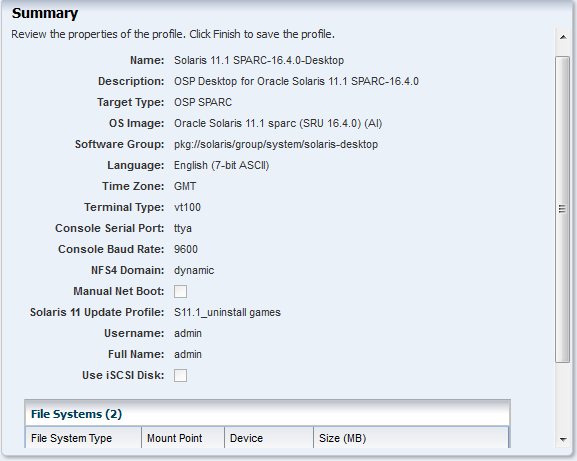
Description of the illustration osp_summary.png
The profile appears in the center pane and in the Profiles and Policies section of Plan Management.
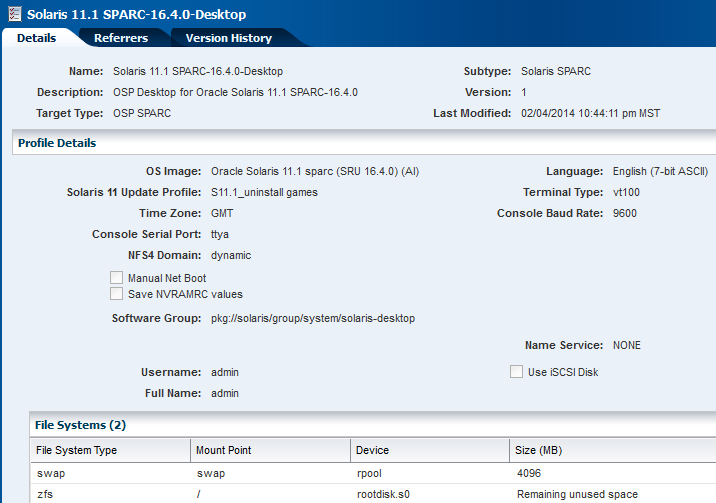
Description of the illustration osp_details.png
3.3 Create an OS Configuration Profile for an Oracle Solaris 11 Operating System
The OS Configuration profile defines how the OS is managed (with or without an agent) and the networking options. The profile is platform-specific, but not SRU-specific.
The OS Configuration profile lets you define the network interface that you want to use on the operating system. The first interface you define in this wizard is the boot interface and also the primary interface. You can add more than one network interface. When you apply the plan to a target, you can select which network interface is the primary interface and define the IP address.
Note:
Before you begin, contact your network administrator for the list of available networks and interfaces.This wizard lets you choose from a list of 32 interfaces. The 32 interfaces are all possible network interfaces, not available interfaces.
By default, the primary interface is the boot interface. You can change the primary interface to a different interface when you deploy the plan.
You can create an OS Configuration profile by creating a new profile or copying a default profile and then editing the profile. This example copies a default SPARC profile.
-
Expand Plan Management in the Navigation pane, then select OS Configuration in the Profiles and Policies tree.
A list of existing OS Configuration profiles appears in the center pane.
-
Click Copy Profile in the Actions or center pane.
-
Name the profile and enter a profile description. Select Solaris and OSP SPARC as the Subtype and Target Type. Click Next.
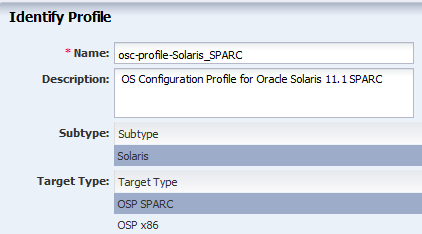
Description of the illustration osc_id_profile.png
-
The default setting is to automatically manage the operating system with Oracle Enterprise Manager Ops Center and Deploy the Agent Controller. This option provides the most robust management capabilities. Deselect MPxIO for this example, as we do not want to enable SAN storage connectivity for the desktop system that is the target for this profile. Click Next.
Note:
If you are going to use a SAN storage library and want to use iSCSI to create LUNs for virtual guests, such as zones, select Enable MPxIO.
Description of the illustration os_mgmt.png
-
Select None for the Networking Services and click Next.
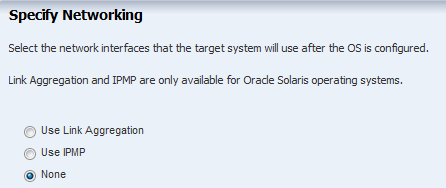
Description of the illustration osc_nw_none.png
-
Select the network interface that you want to use in the configuring process. The boot interface is always the first interface that appears in the table. If you want to add another interface, click the Add icon and select a network interface that you know is available. Click Next.
Note:
Contact your network administrator for the list of available networks and interfaces.This example uses the
net_0interface as the primary and boot interface, andnet_10as a second network interface.Note:
By default, the primary interface is the boot interface. You can change the primary interface to a different interface when you apply the plan to targets.
Description of the illustration osc_nw_interface.png
-
Review the summary of the parameters selected for configuring Oracle Solaris 11 operating system, then click Finish to create the OS Configuration profile.
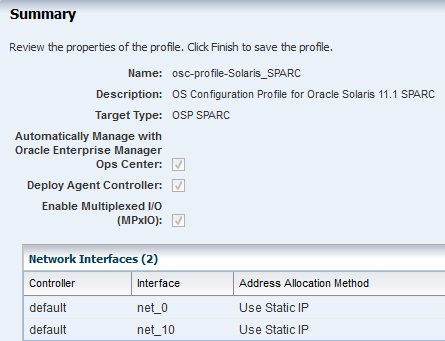
Description of the illustration osc_summary.png
Expand the Plan Management section. In the section OS Configuring of Profiles and Policies section you can select the OS Configuration profile to view its details in the center pane.
3.4 Create a Provision OS Deployment Plan
To provision the operating system, associate the OS Provisioning profile and OS Configuration profile with a deployment plan. Several different types of deployment plans use OS Provisioning and OS Configuration profiles. This example uses a Provision OS deployment plan. When you create a plan you can configure the plan to to stop when a step fails to complete or for the plan to complete as many of the steps as possible. This plan will use the default, which is stop at failure.
Note:
When you create the plan, both the OS Provisioning profile and the OS Configuration profile must have the same platform subtype. This example uses the Solaris SPARC subtype for both profiles.-
Expand Plan Management, expand Deployment Plans, then select Provision OS in the Navigation pane.
-
Click Create Plan from Template in the Actions pane.
-
Name the plan and provide a description.
-
For each step, click the Associated Profile/Deployment Plan field to display a list of available profiles. Select the OS Provisioning profile and OS Configuration profiles that you created earlier.

Description of the illustration osp_plan_steps.png
-
Click Save to create the Provision OS deployment plan.
The plan appears in the Provision OS section of Deployment Plans. Click the plan to see details in the center pane.
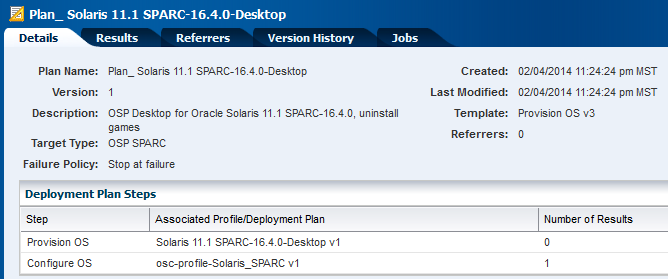
Description of the illustration osp_new_plan.png
3.5 Discover the Service Processor
You must discover the service processor before you can provision the hardware. Because this example describes provisioning a configured service processor, create a discovery profile to discover the service processor. For bare metal systems with unconfigured service processors, use the Declare Server option. See Related Articles and Resources for links to related information and articles.
You can discover individual service processors, or you can create a discovery file that contains the information to add several service processors at the same time.
This example shows how to create a generic discovery profile to add a single server. You will add the IP address and discovery credentials for the service processor as part of the discovery. After you create the discovery profile, you can use the profile and edit, as needed, to add service processors in the future.
-
Expand Assets in the Navigation pane. Right-click All Assets, then click Add Assets, or click Add Assets in the Actions pane.
-
Select Add and manage various types of assets via discovery probes, then click Next.

Description of the illustration add_manage.png
-
Click the Create Profile icon to create a discovery profile to discover ILOM service processors.
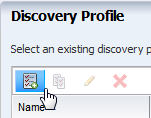
Description of the illustration create_disc_profile.png
-
Enter a name and description for the profile.
-
Expand Server Hardware, then select ILOM Service Processor.
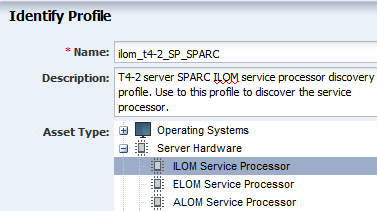
Description of the illustration id_disc_profile.png
-
Click Next.
-
Tags are not used in this example, click Next.
-
You can add IP ranges now, or later. For this example, IP ranges are added later, click Next.
-
Click Select for SSH and IPMI to select and add the SSH and IPMI discovery credentials that you created earlier, then click Next. To create discovery credentials, click New and complete the wizard.

Description of the illustration discovery_creds.png
-
Click Finish.
-
-
Select the discovery profile and enter the following server information, then click Add Now:
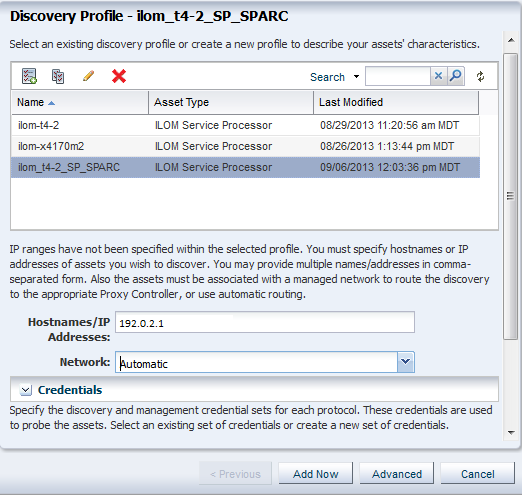
Description of the illustration disc_profile_t4.png
-
IP Address: Specify an IP address to route the discovery to the correct Proxy Controller. You do not need to use a server's actual IP address. You can use an IP address that is on the same subnet as the server to be discovered.
-
Network: Select Automatic. To point to a specific network, click the menu to view available networks.
-
Model: Select the hardware model.
-
A job starts to discover the asset. When the job completes successfully, expand Servers in Assets to see the service processor.
3.6 Apply the Deployment Plan to Provision a System
To select targets to provision and begin a provisioning job, apply the deployment plan.
-
Expand Plan Management, expand Deployment Plans, expand Provision OS, then select the plan that you created. The plan details appear in the center pane.

Description of the illustration osp_new_plan.png
-
Click Apply Deployment Plan in the Actions pane.
-
Expand Servers in the target selector. Select the target assets and click Add to Target List. Click Next.
The default setting filters the assets according to the plan's characteristics. You can only select eligible systems to add to the Target List.
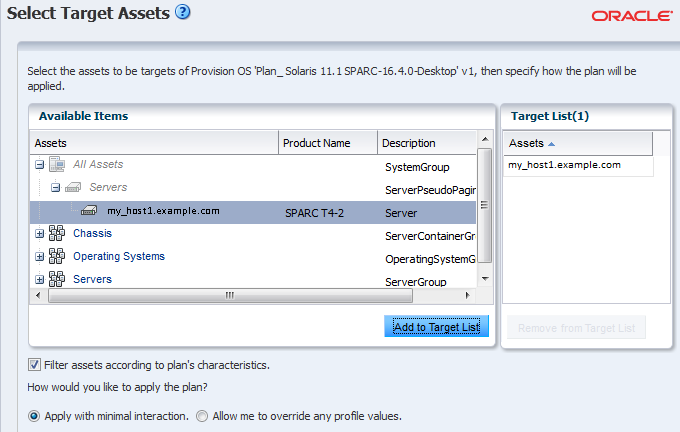
Description of the illustration select_target.png
-
On the Introduction page, the check box is selected to skip steps that are not included in the plan. Click Next.

Description of the illustration plan_step1.png
-
On the Provision OS page, click Next.

Description of the illustration plan_s2.png
-
Define the boot interface resource assignments by select a network from the list of available networks and entering an IP Address and host name. Click Next.
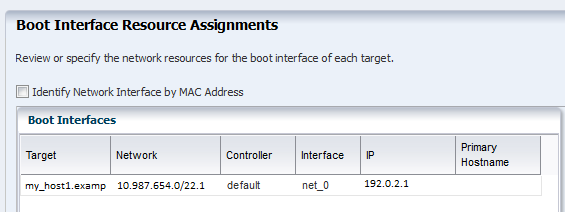
Description of the illustration plan_boot.png
-
Review the Provision OS Summary, then click Next.

Description of the illustration plan_s4.png
-
Click Next to complete the OS Configuration steps.

Description of the illustration plan_s5.png
-
Define the IP address for each network and select which network is the primary network. By default, the boot interface that is defined in the OS Configuration profile appears as the primary interface. Click Next.
Other than selecting which network is the primary network interface, the IP address field is the only editable field.

Description of the illustration plan_s6.png
-
Select Do not assign to a Server Pool. Click Next.

Description of the illustration plan_7.png
-
Review the OS Configuration Summary, then click Next.

Description of the illustration plan_s8.png
-
Select Now to schedule the job for now. Click Apply to apply the deployment plan and begin the OS provisioning job.
The provisioning job takes time to complete. You can view the progress and status of the provisioning job from the Jobs pane.
When the job is completed, go to Assets and expand Servers to see your operating system. Click the operating system in the Navigation pane to display the details in the center pane.
4 What's Next?
You can use the OS Provisioning and OS Configuration profiles to consistently and quickly provision operating systems. You can also use the profiles and deployment plans as building blocks in multi-step or complex plans. For example, depending on the plan, you can either use the OS Provisioning and OS Configuration profiles or the Provision OS deployment plan as steps in the following plans:
-
Install Server: This multi-step plan contains steps that use profiles to deploy a server. With this plan you can provision the operating system, update the BIOS, update the operating system, install software, execute preinstall and postinstall scripts, add operational profiles, add monitoring profiles, and create guests.
-
Configure and Install Dynamic System Domain: This multi-step plan contains steps that use a profile to create a Dynamic System Domain and the Install Server plan to install and update the operating system.
-
Configure M-Series Hardware, Create and Install Domain: This complex plan contains steps that use profiles to configure a service processor, update firmware, and create a Dynamic System Domain. You can add a step to use the Install Server plan to install and update the operating system on an M-series system.
-
Configure Server Hardware and Install OS: This complex plan contains steps that use profiles to configure the service processor, configure the RAID Controller, and update firmware. You can add a step to use the Install Server plan to install and update the operating system.
When you create a multi-step or complex plan from the template, you often have the choice to add or skip steps. You can choose to skip steps, such as updating the BIOS.
5 Related Articles and Resources
The Oracle Enterprise Manager Ops Center 12c Release 2 documentation is available at http://docs.oracle.com/cd/E40871_01/index.htm.
The following chapters in the Oracle Enterprise Manager Ops Center Feature Reference Guide contain more information:
-
See Asset Management for more information on discovery, declaring servers, and an example discovery file.
-
See Plans and Profiles for information about plans and profiles, including using complex plans.
-
See Operating System Provisioning for more information about OS provisioning.
-
See Discovering and Managing Hardware for how to create SSH and IPMI credentials.
The Oracle Enterprise Manager Ops Center Administration Guide has information about user roles and permissions.
For end-to-end examples, see the workflows and how to documentation in the Deploy How To library at http://docs.oracle.com/cd/E40871_01/nav/deployhowto.htm and the Operate How To library at http://docs.oracle.com/cd/E40871_01/nav/operatehowto.htm.
For in-depth information about Oracle Solaris 11, see the Oracle Solaris 11 documentation at http://docs.oracle.com/cd/E23824_01/index.html.
6 Documentation Accessibility
For information about Oracle's commitment to accessibility, visit the Oracle Accessibility Program website at http://www.oracle.com/pls/topic/lookup?ctx=acc&id=docacc.
Oracle customers that have purchased support have access to electronic support through My Oracle Support. For information, visit http://www.oracle.com/pls/topic/lookup?ctx=acc&id=info or visit http://www.oracle.com/pls/topic/lookup?ctx=acc&id=trs if you are hearing impaired.
Oracle Enterprise Manager Ops Center Provisioning Oracle Solaris 11 Operating Systems, 12c Release 2 (12.2.2.0.0)
E47845-03
Copyright © 2007, 2014, Oracle and/or its affiliates. All rights reserved.
This software and related documentation are provided under a license agreement containing restrictions on use and disclosure and are protected by intellectual property laws. Except as expressly permitted in your license agreement or allowed by law, you may not use, copy, reproduce, translate, broadcast, modify, license, transmit, distribute, exhibit, perform, publish, or display any part, in any form, or by any means. Reverse engineering, disassembly, or decompilation of this software, unless required by law for interoperability, is prohibited.
The information contained herein is subject to change without notice and is not warranted to be error-free. If you find any errors, please report them to us in writing.
If this is software or related documentation that is delivered to the U.S. Government or anyone licensing it on behalf of the U.S. Government, then the following notice is applicable:
U.S. GOVERNMENT END USERS: Oracle programs, including any operating system, integrated software, any programs installed on the hardware, and/or documentation, delivered to U.S. Government end users are "commercial computer software" pursuant to the applicable Federal Acquisition Regulation and agency-specific supplemental regulations. As such, use, duplication, disclosure, modification, and adaptation of the programs, including any operating system, integrated software, any programs installed on the hardware, and/or documentation, shall be subject to license terms and license restrictions applicable to the programs. No other rights are granted to the U.S. Government.
This software or hardware is developed for general use in a variety of information management applications. It is not developed or intended for use in any inherently dangerous applications, including applications that may create a risk of personal injury. If you use this software or hardware in dangerous applications, then you shall be responsible to take all appropriate fail-safe, backup, redundancy, and other measures to ensure its safe use. Oracle Corporation and its affiliates disclaim any liability for any damages caused by use of this software or hardware in dangerous applications.
Oracle and Java are registered trademarks of Oracle and/or its affiliates. Other names may be trademarks of their respective owners.
Intel and Intel Xeon are trademarks or registered trademarks of Intel Corporation. All SPARC trademarks are used under license and are trademarks or registered trademarks of SPARC International, Inc. AMD, Opteron, the AMD logo, and the AMD Opteron logo are trademarks or registered trademarks of Advanced Micro Devices. UNIX is a registered trademark of The Open Group.
This software or hardware and documentation may provide access to or information about content, products, and services from third parties. Oracle Corporation and its affiliates are not responsible for and expressly disclaim all warranties of any kind with respect to third-party content, products, and services unless otherwise set forth in an applicable agreement between you and Oracle. Oracle Corporation and its affiliates will not be responsible for any loss, costs, or damages incurred due to your access to or use of third-party content, products, or services, except as set forth in an applicable agreement between you and Oracle.
